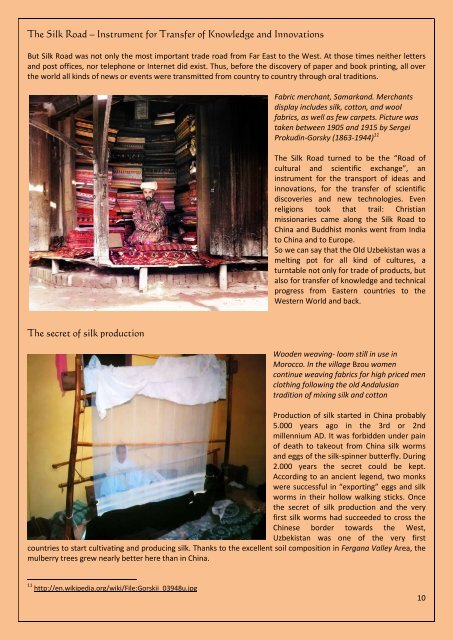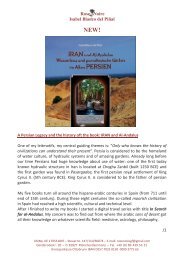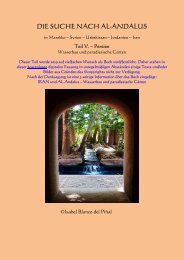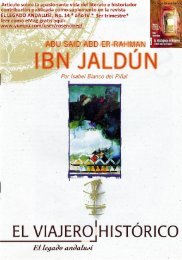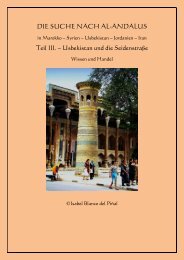IN SEARCH FOR AL-ANDALUS, Part III. - Uzbekistan and the Silk Road
The contribution shows the close relationship between the Silk Road, the ancient Uzbekistan and al-Andalus, the Medieval Muslim Spain. From 10th to 15th century al-Andalus was the country with the highest cultural, technical and scientific level in the Western World. From al-Andalus, all innovations and scientific discoveries and knowledge spread out to Medieval Europe. So, the question was: "What had the Silk Road and the old Uzbekistan to do with al-Andalus, the Muslim Spain?"
The contribution shows the close relationship between the Silk Road, the ancient Uzbekistan and al-Andalus, the Medieval Muslim Spain. From 10th to 15th century al-Andalus was the country with the highest cultural, technical and scientific level in the Western World. From al-Andalus, all innovations and scientific discoveries and knowledge spread out to Medieval Europe.
So, the question was: "What had the Silk Road and the old Uzbekistan to do with al-Andalus, the Muslim Spain?"
You also want an ePaper? Increase the reach of your titles
YUMPU automatically turns print PDFs into web optimized ePapers that Google loves.
The <strong>Silk</strong> <strong>Road</strong> – Instrument for Transfer of Knowledge <strong>and</strong> Innovations<br />
But <strong>Silk</strong> <strong>Road</strong> was not only <strong>the</strong> most important trade road from Far East to <strong>the</strong> West. At those times nei<strong>the</strong>r letters<br />
<strong>and</strong> post offices, nor telephone or Internet did exist. Thus, before <strong>the</strong> discovery of paper <strong>and</strong> book printing, all over<br />
<strong>the</strong> world all kinds of news or events were transmitted from country to country through oral traditions.<br />
Fabric merchant, Samark<strong>and</strong>. Merchants<br />
display includes silk, cotton, <strong>and</strong> wool<br />
fabrics, as well as few carpets. Picture was<br />
taken between 1905 <strong>and</strong> 1915 by Sergei<br />
Prokudin-Gorsky (1863-1944) 11<br />
The <strong>Silk</strong> <strong>Road</strong> turned to be <strong>the</strong> “<strong>Road</strong> of<br />
cultural <strong>and</strong> scientific exchange”, an<br />
instrument for <strong>the</strong> transport of ideas <strong>and</strong><br />
innovations, for <strong>the</strong> transfer of scientific<br />
discoveries <strong>and</strong> new technologies. Even<br />
religions took that trail: Christian<br />
missionaries came along <strong>the</strong> <strong>Silk</strong> <strong>Road</strong> to<br />
China <strong>and</strong> Buddhist monks went from India<br />
to China <strong>and</strong> to Europe.<br />
So we can say that <strong>the</strong> Old <strong>Uzbekistan</strong> was a<br />
melting pot for all kind of cultures, a<br />
turntable not only for trade of products, but<br />
also for transfer of knowledge <strong>and</strong> technical<br />
progress from Eastern countries to <strong>the</strong><br />
Western World <strong>and</strong> back.<br />
The secret of silk production<br />
Wooden weaving- loom still in use in<br />
Morocco. In <strong>the</strong> village Bzou women<br />
continue weaving fabrics for high priced men<br />
clothing following <strong>the</strong> old Andalusian<br />
tradition of mixing silk <strong>and</strong> cotton<br />
Production of silk started in China probably<br />
5.000 years ago in <strong>the</strong> 3rd or 2nd<br />
millennium AD. It was forbidden under pain<br />
of death to takeout from China silk worms<br />
<strong>and</strong> eggs of <strong>the</strong> silk-spinner butterfly. During<br />
2.000 years <strong>the</strong> secret could be kept.<br />
According to an ancient legend, two monks<br />
were successful in “exporting” eggs <strong>and</strong> silk<br />
worms in <strong>the</strong>ir hollow walking sticks. Once<br />
<strong>the</strong> secret of silk production <strong>and</strong> <strong>the</strong> very<br />
first silk worms had succeeded to cross <strong>the</strong><br />
Chinese border towards <strong>the</strong> West,<br />
<strong>Uzbekistan</strong> was one of <strong>the</strong> very first<br />
countries to start cultivating <strong>and</strong> producing silk. Thanks to <strong>the</strong> excellent soil composition in Fergana Valley Area, <strong>the</strong><br />
mulberry trees grew nearly better here than in China.<br />
11 http://en.wikipedia.org/wiki/File:Gorskii_03948u.jpg<br />
10


